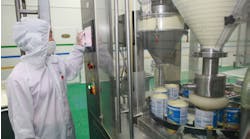Engineers at Rutgers University, New Brunswick, N.J., have demonstrated that stirring a mixture of granular ingredients faster or longer in pharmaceutical or food manufacturing doesn’t always produce a smooth blend. They also found that ingredients that appeared thoroughly mixed may separate. These findings could help manufacturers of products as diverse as medicine, fertilizers, breakfast cereal, cosmetics and road paving materials make better products with less waste.
The most striking finding reported by Ben Glasser, professor of chemical and biochemical engineering at Rutgers University, and his colleagues was the tendency of fine particles to separate into distinct layers under conditions that would otherwise seem to cause thorough mixing. They noticed that at lower mixing speeds, fine glass beads of different sizes started to mix uniformly. But as the speed increased, the beads began to form distinct layers, of which the number and thickness varied with rotation speed. The researchers were able to identify patterns of granular motion that promoted layer formation and interfered with achieving uniform mixing.
“While mixing dry ingredients would seem to be a simple undertaking, getting uniform batches on a large scale can be a challenge for industries,” Glasser says. “The consequences of uneven blending could range from a box of raisin bran without enough raisins to pills that don’t have the safe or effective amount of active pharmaceutical.”
Glasser says researchers have long studied how liquids and gases act when stirred and discovered how “uniform flow degrades into turbulence.” This concept has been applied to manufacturing, aviation, pollution control and weather prediction. But, he says, “We still don’t know that much about powder or granular mixing dynamics.”

